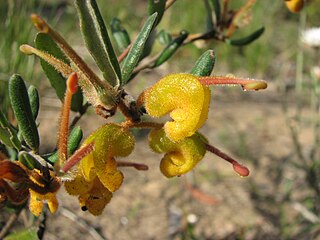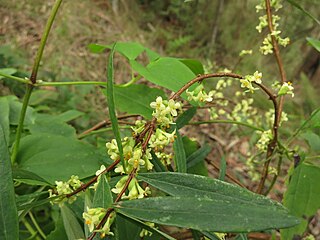
Banksia ornata, commonly known as desert banksia, is a species of shrub that is endemic to south-eastern continental Australia. The Ngarrindjeri people of the Lower Murray region in South Australia know it as yelakut. It has thin bark, serrated, narrow egg-shaped leaves with the lower end towards the base, cream-coloured flowers in a cylindrical spike, and later, up to fifty follicles in each spike, surrounded by the remains of the flowers.

Grevillea chrysophaea, commonly known as golden grevillea, is a species of flowering plant in the family Proteaceae and is endemic to Victoria in Australia. It is a spreading shrub with oblong to almost linear leaves, and dull to golden yellow flowers with a red or orange-red style.

Leptospermum myrsinoides, commonly known as the heath tea-tree or silky tea-tree, is a species of shrub that is endemic to south-eastern continental Australia. It has smooth bark on the younger stems, narrow egg-shaped leaves with the narrower end towards the base, white flowers and fruit that has the remains of the sepals attached but usually falls from the plant soon after the seeds are released.

Prostanthera striatiflora, commonly known as jockey's cap, striated mintbush or striped mintbush, is a species of flowering plant that is endemic to the more arid areas of Australia. It is an erect, aromatic shrub with narrow egg-shaped to narrow elliptic leaves and white flowers with purple lines inside the petal tube.

Goodenia albiflora, commonly known as white goodenia, is a species of flowering plant in the family Goodeniaceae and endemic to South Australia. It is a small, erect shrub with ridged stems, elliptic to egg-shaped, cauline leaves, racemes of white flowers with leaf-like bracteoles at the base, and oval fruit.

Pimelea hewardiana, commonly known as forked rice-flower, is a species of flowering plant in the family Thymelaeaceae and is endemic to south-eastern continental Australia. It is a shrub with narrowly elliptic leaves and head-like clusters of 7 to 34 unisexual yellow flowers.

Billardiera sericophora is a species of flowering plant in the family Pittosporaceae and is endemic to the south-east of South Australia. It is spreading shrub or climber that has mostly narrowly elliptic leaves and pendent yellow flowers arranged singly or in pairs.

Acacia bynoeana, known colloquially as Bynoe's wattle or tiny wattle, is a species of Acacia native to eastern Australia. It is listed as endangered in New South Wales and as vulnerable according to the Environment Protection and Biodiversity Conservation Act 1999.

Hakea rostrata, common name beaked hakea, is a flowering plant in the family Proteaceae, native to South Australia and Victoria.

Pimelea axiflora, commonly known as bootlace bush, is a small shrub in the family Thymelaeaceae and is endemic to Australia. It is a small shrub with whitish flowers on mostly smooth stems.

Sarcozona praecox, commonly known as sarcozona, is species of flowering plant in the family Aizoaceae and is endemic to Australia. It is a small erect to low-lying, succulent shrub with leaves that are triangular in cross-section and arranged in opposite pairs, and daisy-like flowers with twenty to eighty pink, petal-like staminodes and 20 to 150 stamens.

Dampiera rosmarinifolia, commonly known as rosemary dampiera, is a flowering plant in the family Goodeniaceae.It is a perennial subshrub with linear leaves, mauve or purple flowers borne in leaf axils.

Spyridium coactilifolium, commonly known as butterfly spyridium, is a species of flowering plant in the family Rhamnaceae. It has white-velvety flowers and oval shaped leaves that are thickly covered in soft hairs.

Olearia muelleri, commonly known as Mueller daisy bush, Mueller's daisy bush or Goldfields daisy, is a species of flowering plant in the family Asteraceae and is endemic to southern continental Australia. It is a compact or spreading shrub with scattered spatula-shaped to egg-shaped leaves with the narrower end towards the base, and white and yellow, daisy-like inflorescences.
Pomaderris flabellaris, commonly known as fan pomaderris, is a species of flowering plant in the family Rhamnaceae and is endemic to South Australia. It is a low shrub with fan-shaped leaves, and small clusters of woolly-hairy flowers.

Pomaderris helianthemifolia is a species of flowering plant in the family Rhamnaceae and is endemic to south-eastern continental Australia. It is a bushy shrub with hairy young stems, narrowly elliptic to lance-shaped leaves with the narrower end towards the base, and small panicles of hairy yellowish flowers.
Olearia hookeri, commonly known as crimsontip daisybush, is a species of flowering plant in the family Asteraceae and is endemic to Tasmania. It is a sticky shrub with small, narrowly linear leaves and white to bluish-purple and yellow, daisy-like inflorescences.
Olearia picridifolia, commonly known as rasp scrub-daisy, is a species of flowering plant in the family Asteraceae and is endemic to southern continental Australia. It is a low, spreading shrub with narrowly egg-shaped or narrowly elliptic leaves, and blue, mauve or white and yellow, daisy-like inflorescences.
Pimelea micrantha, commonly known as silky rice-flower is a species of flowering plant in the family Thymelaeaceae and is endemic to southern Australia. It is a much-branched undershrub with narrowly elliptic to lance-shaped leaves and compact clusters or heads of densely hairy, creamy white flowers.

Abutilon halophilum is a flowering plant in the family Malvaceae. It is a small understory shrub with yellow or cream-white flowers and hairy oval-shaped leaves and grows in New South Wales, South Australia and the Northern Territory.
















